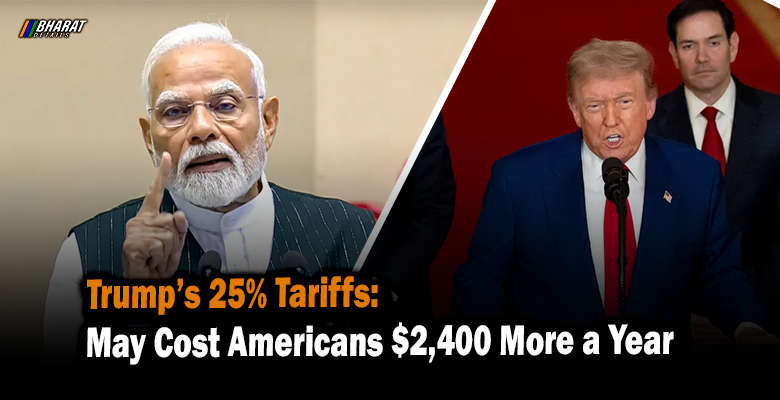Trump’s 25% Tariffs May Cost Americans $2,400 More a Year, But India Could Withstand the Shock

Trump’s 25% tariffs policy could burn a hole in American wallets — but India may just come out of it with lesser damage. According to a research report by Bharat Details based on analysis from SBI Research, the fresh 25% import duty announced by US President Donald Trump could increase annual household expenses in the United States by an average of $2,400. Meanwhile, India, despite being a major trade partner, is expected to remain relatively insulated due to its diverse export basket.
The tariff, which also includes additional penalties for India’s oil imports from Russia, is part of Trump’s aggressive trade policy set to take effect from August 7. Until then, the current 10% duty remains applicable on Indian goods entering the US market.
The SBI Research report explains that inflationary pressure caused by these tariffs will likely keep inflation above the US Federal Reserve’s 2% target until at least 2026. Low-income American households may bear losses around $1,300, while high-income groups could see up to $5,000 in added annual expenses.
The sectors likely to face the brunt in the US include electronics, automobiles, and consumer goods—products that rely heavily on imports. The increased costs may also slow down US GDP growth by 40 to 50 basis points due to reduced consumer spending and rising input prices.
Contents
India: Stirred but Not Shaken
Even though the US is India’s top export market, accounting for nearly 20% of outbound trade, India’s broad-based export structure offers a cushion against this geopolitical jolt. The top 10 countries make up only about 53% of India’s total exports, ensuring no single market can severely disrupt the overall trade flow.
Also read: Book Mumbai Local Train Tickets on WhatsApp – A Digital Boost
The SBI report remarks that India is “stirred, not shaken,” pointing out that the country’s Production Linked Incentive (PLI) schemes and focus on multipolar trade relations provide additional protection. India’s GDP may see a marginal impact of 25–30 basis points in FY26 — a figure significantly lower than the US estimates.
Tariffs vs. Trust: A Policy Mismatch?
While the US tightens its grip with protectionist tariffs, it simultaneously advances crypto legislation like Executive Order 14178 and the GENIUS Act. These aim to integrate stablecoins into mainstream finance and allow crypto firms easier access to banking, which, according to SBI, could weaken trust in the US dollar.
Interestingly, these measures come at a time when India is strengthening its leadership within BRICS and pushing for trade realignments that reduce dependency on the West. The SBI report suggests that Washington’s actions might be more politically motivated, reacting to India’s increasing global assertiveness rather than sound economic rationale.
Trade Breakdown: What India Exports to the US
In FY2024–25, bilateral trade between India and the US touched USD 186 billion, with India exporting USD 86.5 billion worth of goods and maintaining a healthy trade surplus of USD 41 billion. Top export items include:
- Pharmaceuticals ($8.1 billion)
- Telecom instruments ($6.5 billion)
- Precious stones and jewellery ($5.3 billion)
- Petroleum products ($4.1 billion)
- Auto components and garments (approx. $2.8 billion each)
Imports from the US included crude oil ($4.5 billion), petroleum products, coal, aircraft parts, and polished diamonds.
However, with the new tariffs in place, the pricing advantage of Indian products may erode—especially in labour-intensive sectors like textiles, leather, gems, and handicrafts. For example, textiles currently attract a 6–9% US tariff, which will now shoot up to 31–34% including the new 25% levy.
What the New Tariffs Look Like
- Telecom Equipment: 25%
- Gems & Jewellery: 30–38.5%
- Food & Agri Products: 29–30%
- Apparel & Textiles: 12% base + 25% = 37%
Additionally, steel and aluminium exports will face a 50% duty, while auto parts will bear an extra 25% levy.
Which Indian Sectors Are at Risk?
- Gems & Jewellery: With over $10 billion in US-bound exports, the sector is facing cost inflation and supply chain issues.
- Electronics: India recently overtook China in smartphone exports to the US. The tariffs could disrupt future shipments.
- Textiles & Apparel: Home-grown brands working with global giants like Walmart and Gap will lose competitive pricing.
- Pharmaceuticals: India’s non-patented drugs, valued at $8 billion annually, may face volume pressure despite their cost advantage.
- Oil Refining: With 37% of crude imports coming from Russia, any disruption could spike costs for Indian refiners.
Final Take
While Donald Trump’s 25% tariff move is designed to protect American interests, it appears to be a double-edged sword. With rising household costs, slowed economic growth, and a shaky policy stance, the US might end up absorbing more pain than it inflicts. India, thanks to trade diversification and economic resilience, seems better positioned to weather this new wave of protectionism.
Stay updated with Bharat Details for more insights into how global policies affect the Indian economy.

